Best Ways To Prepare A Turkey, According To Top Celebrity Chefs
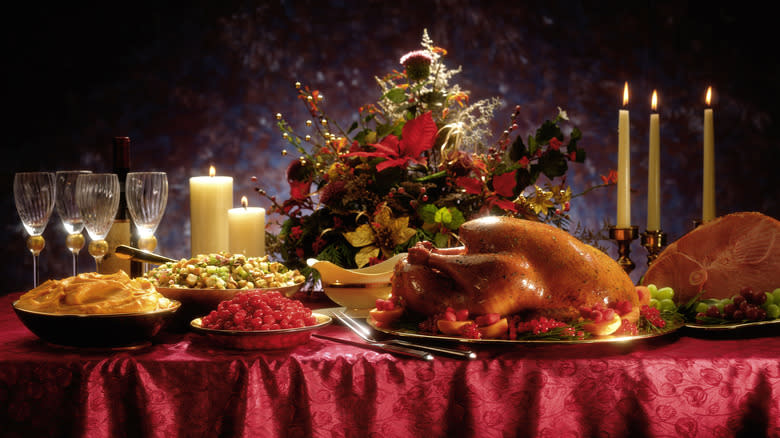
Whether you're planning a special holiday meal or simply love the taste of turkey on the tongue, nothing beats knowing how to cook a classic bird right. Now, we'll admit, cooking a turkey isn't easy and isn't for the faint of heart. Its lean characteristics make it so that it easily dries out, rendering a tough and chewy result if you don't know what you're doing. On top of that, turkeys tend to run big and thus can be hard to cook through, leaving you with pink, unsafe, and unappetizing meat rather than that luscious and juicy result we all hope to achieve.
Thankfully, we've got celebrity chefs with tons of experience to turn to when we need a culinary boost in the kitchen. We've looked intently at some of the most prominent turkey recipes to pull out the most useful tips just to share them with all of you.
With that said, let's get into carving out some celebrity chef advice to get you that much closer to dishing up your best turkey yet.
Read more: What The Cameras Don't Show You On MasterChef
Leave No Part Of The Turkey Unseasoned - Gordon Ramsay
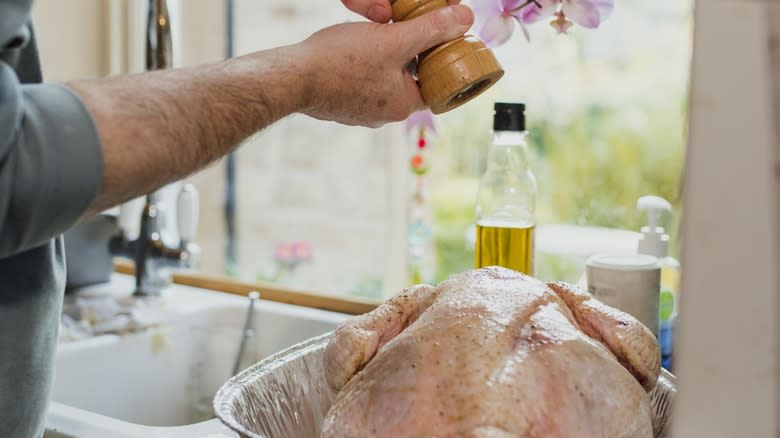
Most of us know the importance of seasoning a turkey, but there's a specific way to season it that can really help take its depth of flavor to the next level. Don't believe us? Try Gordon Roamsay's method the next time you prepare your turkey, and savor the difference.
According to Gordon Ramsay, seasoning the outside, inside, and even in between the skin and the meat is crucial to making a delicious turkey. To begin, you'll want to separate the skin of the bird and smear room-temperature butter between the skin and your turkey meat. To this butter, consider adding lemon juice and herbs, just as Ramsay suggests, for additional depth of flavor.
You'll also want to season the cavity of the turkey. As weird as it seems, giving your turkey a little love from the inside out makes a difference. Using salt and pepper, go ahead and season the hollow inside (after removing all giblets and packaging, of course) before stuffing it full of goodies like lemon, herbs, and garlic. Finally, season the outer skin with salt and pepper to enjoy a well-seasoned, tasty turkey you can feel confident about.
Don't Be Afraid Of Non-Traditional Seasonings - Carla Hall
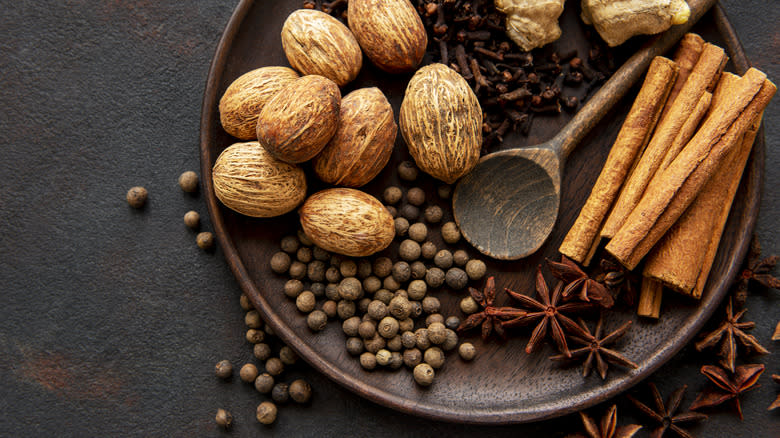
We admit that it's sometimes easy to get stuck in a rut when it comes to serving up classic dishes like roasted turkey. Seasonings like lemon, garlic, herbs, and onion are incredibly common as many of us tend to do less adventuring when whipping up traditional fare.
When it comes to Carla Hall's turkey recipe, there's no need to fear the mundane; she utilizes all sorts of spices for her pan-seared turkey, including cloves, red pepper flakes, star anise, allspice berries, and more. For the relish topping, she uses sugar, wine, ginger, cranberries, and pears. Talk about unique!
We do realize that many of these spices and flavorings are naturally associated with the holidays, and we're sure that's the reason she chose them. Even so, we rarely see ingredients like these on turkey, making it an interesting and unique take on a traditional classic from Carla Hall.
Using Cheesecloth Is Key - Martha Stewart
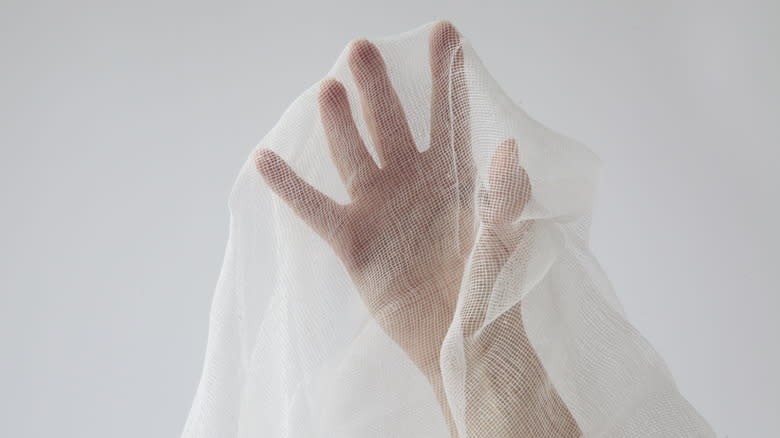
Martha Stewart has bases covered for simple yet effective cooking techniques. When it comes to roasting a turkey, Martha uses a specific hack that aims to make turkey taste that much better. Her secret? Using cheesecloth. According to Stewart, cheesecloth does well to prevent your turkey from over-browning while also keeping the liquids used for basting close to the meat. After the first couple of hours, the cheesecloth is removed to allow the skin of the bird to brown, producing a crispy yet still flavorful and juicy bird that everyone can enjoy.
How exactly should you go about using this technique? Martha suggests that you soak the cheesecloth in melted butter and dry white wine first before laying it over the breast of the turkey. Allow the soaked cloth to cling to your turkey until the final hour of baking, making sure to baste it every 30 minutes, both when the cheesecloth is on and when it is off.
This technique sounds like a winner to us, and we're surprised we don't hear much about other chefs doing it. Hats off to you, Martha — we're definitely going to give this one a try.
Use A Spiced Brine For Best Flavor - Alton Brown
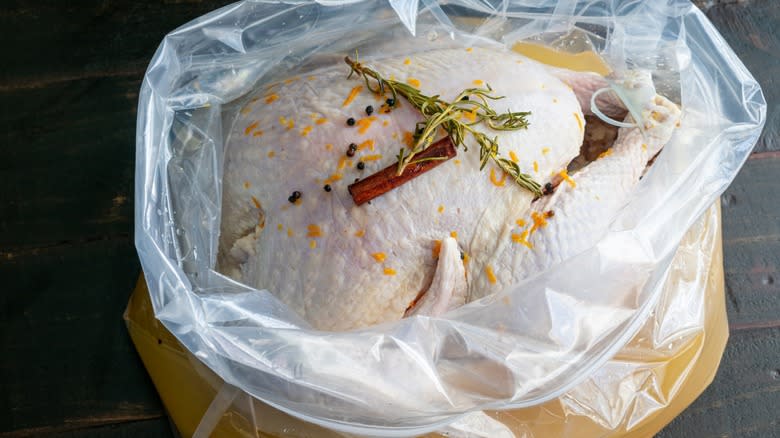
There's no need to stop at salt and water when it comes to prepping a brine solution for tender and juicy turkey meat. Alton Brown knows this all too well, as he recommends adding spices to his brine which, apparently, work to make your turkey that much better.
To follow the Alton Brown version of brining, you'll first need to cook the brine itself. According to Brown, this brine solution needs to come to a boil before it can be properly used. Start by combining vegetable stock with peppercorn, allspice berries, candied ginger, salt, and light brown sugar in a pot. Once you've brought the solution to a boil, allow it to cool to room temperature before chilling it in the fridge. Once ready to make your turkey, combine your chilled solution with one gallon of ice water and use this to submerge your turkey. Brine your turkey this way for at least 8 hours (16 hours at most) before removing it and completing the rest of the recipe.
Judging by all the rave reviews, we're led to believe this recipe is worth the hassle. It'll take a little more time, but if it's deliciously moist turkey you crave, this just might be the answer for you.
Use Foil And Broth To Your Advantage - Giada De Laurentiis
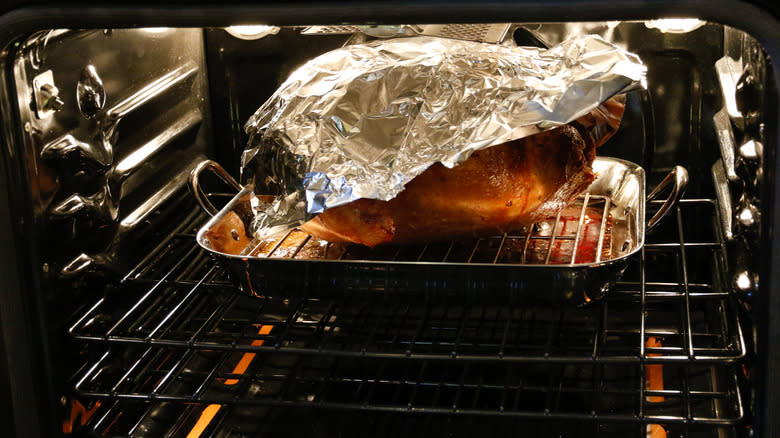
Whether or not to use foil when roasting a turkey tends to be a controversial issue among chefs and home cooks alike. People tend to fuss over which method is most suitable to get the best-tasting and best-looking bird. With that said, it seems that Giada De Laurentiis has a strong opinion in this arena, though we must say, the process she uses is rather intense.
According to her Turkey with Herbes de Provence and Citrus recipe, Giada goes to great lengths to ensure her turkey stays juicy while also obtaining that coveted brown roasted hue at the same time. Using her strategy, you'd take a turkey, cover the breast with foil, and roast for 20 minutes. You'd then add herbs and broth and continue to roast, eventually removing the foil and adding even more broth. You'd then baste the bird occasionally and allow it to continue to cook until it reaches an internal temperature of between 165 and 175 degrees Fahrenheit.
Whew. We don't know about you, but we feel worn out just having read all those steps. We're sure it yields a delicious final turkey, but gee whiz -- you better have enough time on your hands to make this high-maintenance recipe.
Get Inspired By Flavors From Other Countries - Marcus Samuelsson
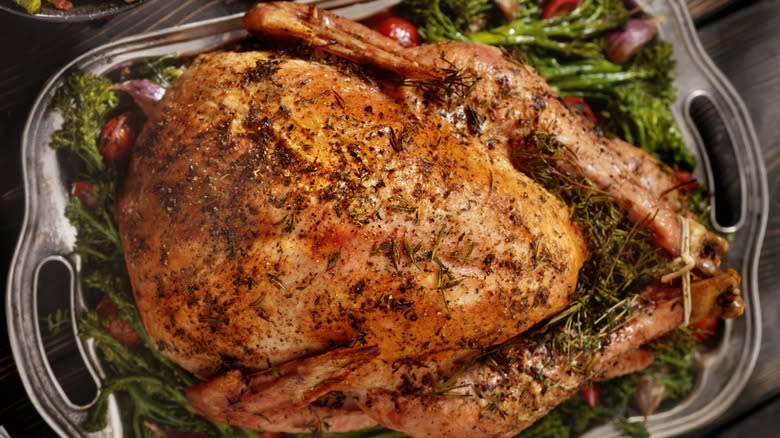
It's one thing to experiment with seasonings frequently used around the holidays, but it's quite another to sample exotic spices and flavorings commonly associated with other countries. Marcus Samuelsson, an Ethiopian-Swedish chef, is known for bringing diversity and multicultural influences to the world of American cuisine. There's probably no better way to showcase what he brings to the table than his recipe for Moroccan-Spiced Turkey.
We know what you're probably thinking. Who wants to sample an exotic turkey on a classic holiday like Christmas or Thanksgiving? Honestly, not everyone will -- and that's okay. Still, if you're looking for something more adventurous or are a person who enjoys turkey even outside of classic holiday fare, this Moroccan-inspired turkey dinner is likely just for you.
To pull this one off, you'll need to ensure you've got the right spices on hand. Marcus Samuelsson requires you to combine the juices of multiple citrus fruits along with garlic, sage, and ras el hanout to achieve the perfect flavor. Other than that, cooking the turkey is pretty much the same as it is with any other recipe; it'll just taste vastly different from what you're probably used to.
Start With A Very Hot Oven - Bobby Flay

Every chef seems to have his or her own way of cooking a turkey. Aside from seasonings, you'll also usually find major differences in temperatures when it comes to cooking up this bird. In the opinion of Bobby Flay, hotter is undoubtedly better — at least in the beginning. According to his Thanksgiving Pioneer-Style Herb Roasted Turkey recipe, it's best to start with a smoldering oven before gradually bumping the heat down rather than to start it at a lower temperature.
To get specific, Bobby Flay recommends starting your oven at 450 -- yes, 450 degrees Fahrenheit -- when roasting a turkey. You'll cook it at this temperature for about 45 minutes before adjusting the heat to 350 degrees Fahrenheit, where it will continue roasting until finished. It's also worth noting that at no point does he ever make mention of covering the turkey with foil while cooking, leaving us to believe that this will lead to a very brown, crisp, and crackly skin -- just how we like it.
Keep It Simple - Ina Garten
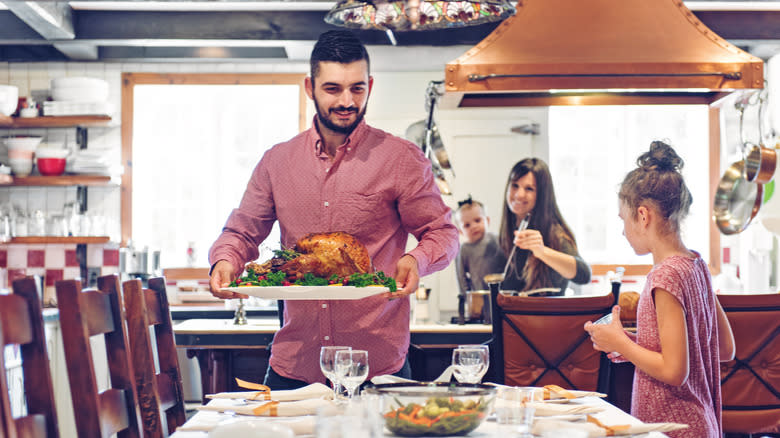
Despite the previous deviations from the norm, we're always quite refreshed to see a straightforward traditional turkey recipe perfect for the no-fuss home chef in all of us. After all, most people have several dishes to make alongside turkey, and as a result, a simpler recipe that doesn't require a ton of effort is always welcome.
One of the easiest turkey recipes we've come across happens to be Ina Garten's Perfect Roast Turkey recipe. Though the recipe still requires you to use melted butter, herbs, lemon, and other seasonings often associated with delicious turkey, it does not require fancy techniques. There's no separating the skin from meat, no fussing with the oven temperatures, no taking foil on and off -- just a simple seasoning while maintaining the turkey at a consistent temperature with typical basting.
To get started, heat your oven to 350 degrees Fahrenheit. Take the giblets out of the turkey, brush seasoned melted butter over the skin, salt and pepper the outside (and inside), and bake. That's it. Thank you, Ina -- taking on the holidays just got that much easier.
Maple And Bacon Give The Turkey Outstanding Flavor - Tyler Florence
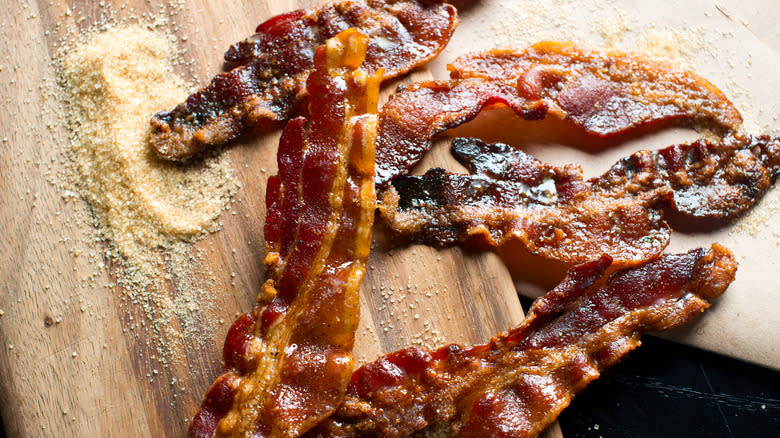
This is an interesting take on turkey, and honestly, we can't wait to try it out next holiday season. Tyler Florence spares no expense when it comes to taking the flavor of turkey to the max, and his Maple-Roasted Turkey with Sage, Smoked Bacon, and Cornbread Stuffing recipe demonstrates this perfectly.
Aside from using a flavorful sage butter for seasoning, Tyler also suggests making a simple but no-less-special maple glaze to baste your turkey with. After two hours in the oven and ongoing basting using this scrumptious glaze, he recommends you then add thick slices of bacon to the top of the turkey to prevent it from over-browning.
If using bacon isn't the ultimate alternative to foil, then we don't know what is. It not only shields the turkey from becoming too brown, but it also imparts an incredible taste to the meat. All the while, the bird is being basted in maple glaze every 30 minutes to yield the ultimate flavor. The results are sweet and savory with hints of butter and sage – honestly, what more could you want?
Slow And Steady Wins The Race - Ree Drummond
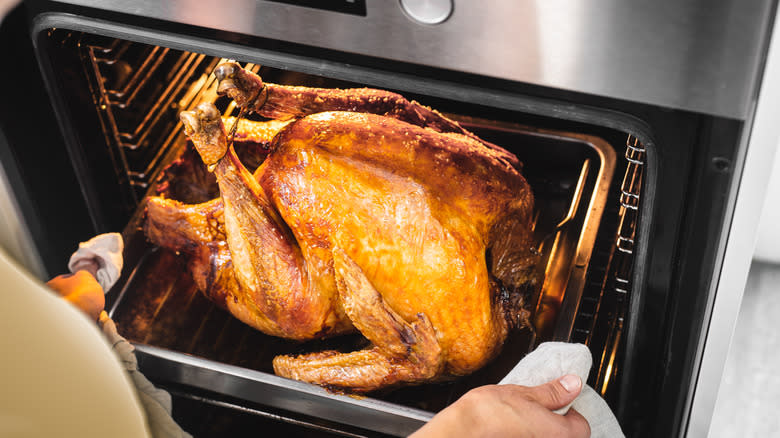
We love Ree Drummond for her tasty yet practical recipes, but her turkey recipe just about takes forever. Her low and slow technique likely has a purpose, with tender and flavorful meat being the end result. Still, keep in mind that it'll likely take you 5 hours or more to complete this showstopping recipe, so make sure you carve out the time for it if you desire a Drummond-style turkey this holiday.
According to Ree, you ought to start your turkey out at 275 degrees Fahrenheit, which is one of the lowest temperatures for cooking turkey we've come across thus far. She recommends you cook the turkey at this temperature for 10 minutes for every pound, meaning a 17-pound turkey will take close to 3 hours -- but brace yourself -- that's only the first round.
For the second round of cooking, you'll need to bump your oven heat to 350 degrees Fahrenheit before placing the turkey back in the oven until it finally reaches 165 degrees Fahrenheit. You'll also need to baste the turkey every 30 minutes to ensure it stays tender and juicy. A recipe like this is probably worth it, but if you're courageous enough to attempt it, make sure to bring an ample supply of patience with you.
Be Sure To Refrigerate Your Bird Uncovered Overnight – Anne Burrell
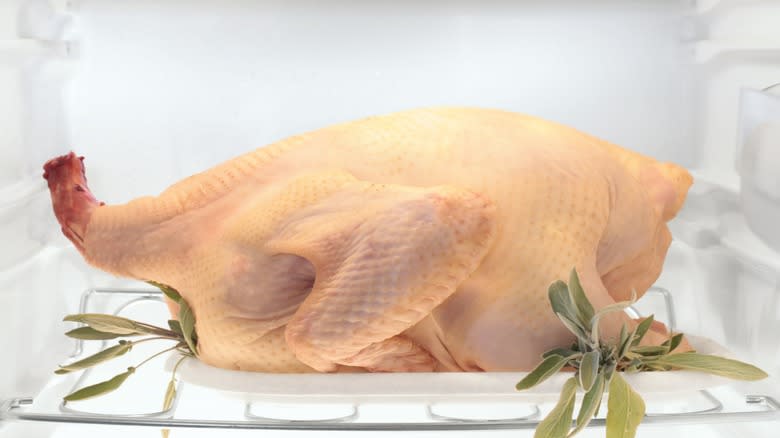
According to Anne Burrell, there's a very important step that many leave out after seasoning a turkey, and that's to allow it to cool uncovered overnight in the fridge. Though most of us know that the safest way to thaw a turkey is in the fridge, this is usually where things stop when utilizing the ice box to prep the bird. With that said, Anne Burrell recommends that you refrigerate your turkey again after seasoning it -- and doing so uncovered is key.
Burrell's argument for leaving the bird uncovered is that it helps dry out the skin, which allows it to crisp up better once in the oven. In addition, we know that allowing a turkey to sit with all of its seasonings overnight is an excellent way to let all the flavors seep into the meat. In the end, this non-traditional but totally sensical technique is perfect for cooking up a tasty bird the next day.
Always Allow The Turkey To Rest Before Carving - Emeril Lagasse
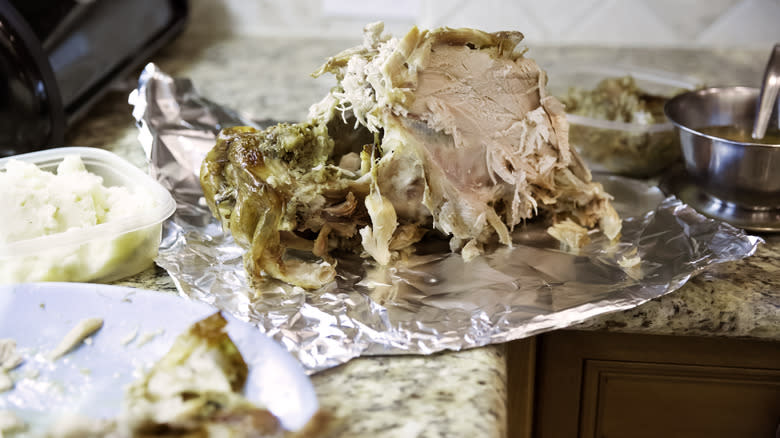
Emeril Lagasse certainly isn't the only chef to understand this concept, but allowing a turkey to rest before carving is serious business. Emeril's Classic Roast Turkey recipe is fairly straightforward, but one thing he makes certain to mention in the directions is that you should allow the turkey to rest at least 20-30 minutes before slicing in.
To be clear, there's a certain science behind letting turkey meat sit before carving, and a lot of it has to do with juiciness. While cutting into a turkey right away may be tempting, doing so may disrupt the process of allowing the juices to redistribute. The result is a drier turkey than you would prefer, and thus, the act of allowing meat to rest before slicing is an important one.
Something else to pay attention to is just how long you allow your turkey to rest. While Emeril recommends 20-30 minutes, we've seen some chefs recommend you wait as long as 3 hours before digging in. We'll let you decide which guidelines you'll follow, but one thing is for certain: Allowing your turkey to rest after cooking is non-negotiable.
Blackened Peppers And Tequila Takes Turkey To New Heights
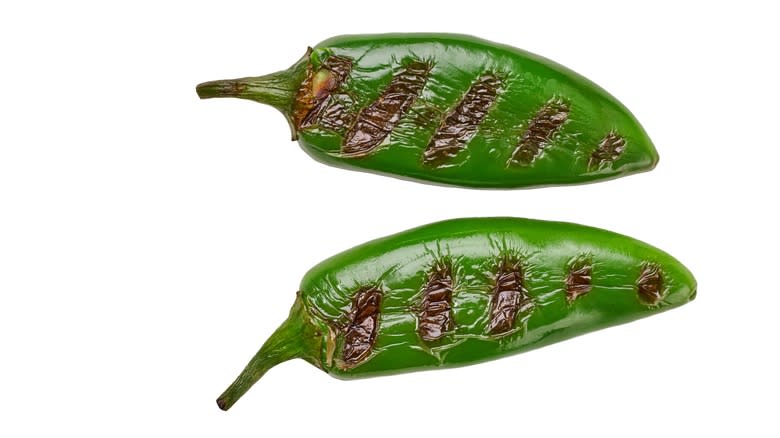
Known for amping up traditional American fare and taking it to its max potential, it's no surprise that Guy Fieri ditches the traditional scene and introduces his own equally delicious version of roasted turkey. His Mean Green Turkey Machine recipe is nothing short of an anomaly, as the famous chef recommends dicing up blackened pasilla and serrano peppers before combining them with aromatics and dousing them in tequila all before pushing the mixture between the skin of the bird and the meat.
Umm ... huh?
Yeah, it sounds pretty foreign to us, too. Still, we have to admit, it does seem like it'd render an intensely flavorful, though still non-traditional, result. In addition, Mr. Fieri takes things one step further by adding cilantro to this already unique-tasting turkey dish, adding it both to the blackened pepper mixture and the cavity of the bird before roasting. We aren't sure we've ever heard of this flavor combination associated with such a classic meal, but hey, it's Guy Fieri we're talking about here. Try it and see what you think.
Read the original article on Mashed.

